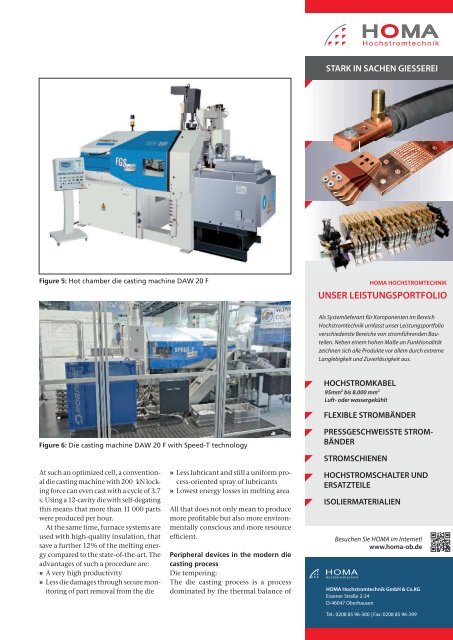CPT International 04/2014
The leading technical journal for the global foundry industry – Das führende Fachmagazin für die weltweite Gießerei-Industrie
The leading technical journal for the
global foundry industry – Das führende Fachmagazin für die
weltweite Gießerei-Industrie
You also want an ePaper? Increase the reach of your titles
YUMPU automatically turns print PDFs into web optimized ePapers that Google loves.
Figure 5: Hot chamber die casting machine DAW 20 F<br />
C<br />
M<br />
Y<br />
CM<br />
MY<br />
CY<br />
CMY<br />
K<br />
Figure 6: Die casting machine DAW 20 F with Speed-T technology<br />
At such an optimized cell, a conventional<br />
die casting machine with 200 kN locking<br />
force can even cast with a cycle of 3.7<br />
s. Using a 12-cavity die with self-degating<br />
this means that more than 11 000 parts<br />
were produced per hour.<br />
At the same time, furnace systems are<br />
used with high-quality insulation, that<br />
save a further 12 % of the melting energy<br />
compared to the state-of-the-art. The<br />
advantages of such a procedure are:<br />
» A very high productivity<br />
» Less die damages through secure monitoring<br />
of part removal from the die<br />
» Less lubricant and still a uniform process-oriented<br />
spray of lubricants<br />
» Lowest energy losses in melting area<br />
All that does not only mean to produce<br />
more profitable but also more environmentally<br />
conscious and more resource<br />
efficient.<br />
Peripheral devices in the modern die<br />
casting process<br />
Die tempering:<br />
The die casting process is a process<br />
dominated by the thermal balance of


















